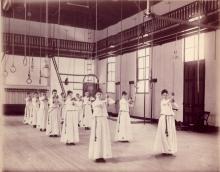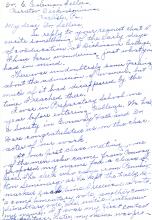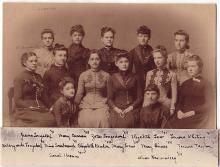Elizabeth Anna Low Agrees to write her Personal Account of Early Coeducation at Dickinson College
In a letter to Dickinson College Historian Charles Coleman Sellers, Elizabeth Anna Low agrees to write her account of early coeducation at Dickinson College. However, she asked Sellers to be more clear on what he expected. In the letter, Low begins describing early coeducation at Dickinson. She explains that "there was undoubtedly some feeling about the admission of women, but much of it had disappeared by the time I reached there." Despite this statement, Low recalls an election in which her name was removed due to her gender and not being admitted to the literary societies.
Photograph Circa 1887 of Early Co-Eds at Dickinson College and Preparatory School
This photograph is a group picture of early female students of both Dickinson College and the Preparatory School from circa 1887. The women included in this picture are Zatae Longsdorff '87, Mary Curran '88, Hildegarde Longsdorff '88, Elizabeth Bender '88, Mary Evans '89, Alice Kronenberg '89, Mary Himes '89, Jennie Taylor '89, Jessica Longsdorff '91, Elizabeth Low '91, Lenora Whiting '91, Wilhemina Scarborough '91, and Sarah Yocum '91.
The Microcosm Addresses Coeducation in 1890
Published in the 1890 Microcosm, “Co-Education†describes the introduction of coeducation at Dickinson College.  The author of the piece asserts that coeducation at Dickinson was a direct result of the Methodist influence at the school and women’s participation within that church. Thus, female students were accepted to the college on the same terms and with the same privileges of their male counterparts. Moreover, the author of the piece adds that the women at Dickinson contributed  to the beauty of the campus.




